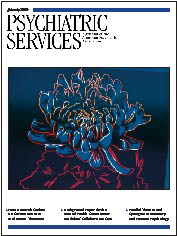Homeless Admissions and Immigration in a State Mental Hospital
A previous report on admissions to a state mental hospital (Chicago-Read Mental Health Center) in Chicago between 1970 and 1980 suggested an increasing rate of homelessness (1). To determine whether this increase was continuing, we gathered data from facility reports for 1996 and the last available year, 2003. We found that the proportion of homeless mentally ill persons who were hospitalized significantly increased over the three study years, from 20.2 percent in 1996 to 29.2 percent in 2003, compared with 15.3 percent in 1980 (χ2=178.9; df=2, p<.001).
In addition to finding the increase, we also found that the homeless population might be changing. Using 1996 data we compared 102 homeless patients who had no previous state hospitalizations with 158 homeless patients who were previously hospitalized. The most striking relationship, based on logistic regression, was that the odds of being a first admission were more than five times higher among foreign-born patients than among those who were native born (odds ratio=5.42, p<.001). This trend continued in 2003—the ratio of foreign-born persons was significantly greater among homeless patients admitted for the first time than among homeless patients who had previous state hospitalizations (21.6 percent compared with 10.8 percent; χ2=4.04, df=1, p<.05).
The increasing proportion of homeless foreign-born patients among new admissions to a state mental hospital probably reflects both the rising number of immigrants to certain areas of the United States and their economic status. U.S. census data for 1998 indicate that nearly 30 percent of recent arrivals to the United States lived in families below the poverty line, compared with 13 percent of the native born. Unemployment rates were higher, household incomes were lower, and twice as many U.S. households with foreign-born residents as native-born residents received some federal benefit. These findings underscore why foreign-born residents may be predisposed toward homelessness (2), a relationship that is receiving considerably more attention in Europe (3).
Although our findings are limited because they are based on a single state mental hospital, they are consistent with demographic changes in the country and possibly with patterns of hospitalization. For example, substantial increases in psychiatric hospitalization rates were recently reported for both Asians and Hispanics in Massachusetts between 1994 and 2000 (4). Although birthplace was not identified, the increase was more than likely the result of an increase in immigrants to that state.
The general psychiatric issues facing minority and foreign-born populations have been outlined by the U.S. Surgeon General (5), although the report only briefly discussed homelessness among immigrants. Our findings would suggest that state mental health planners must be cognizant of these changing populations and the potential for homelessness among the foreign born.
Dr. Appleby is associate professor of psychology in the department of psychiatry at the University of Illinois College of Medicine in Chicago. Dr. Luchins is associate professor of psychiatry at the University of Chicago Pritzker School of Medicine. Dr. Freels is associate professor in the division of epidemiology and biostatistics at the School of Public Health of the University of Illinois at Chicago.
1. Appleby L, Desai PN: Documenting the relationship between homelessness and psychiatric hospitalization. Hospital and Community Psychiatry 36:732–737,1985Abstract, Google Scholar
2. Davis LA, Winkleby MA: Sociodemographic and health-related risk factors among African-American, Caucasian, and Hispanic homeless men: a comparative study. Journal of Social Distress and the Homeless 2:83–101,1993Crossref, Google Scholar
3. Immigration and Homelessness in the European Union. Brussels, FEANTSA [European Federation of National Organisations Working With the Homeless], Oct 2002. Available at www.feantsa.orgGoogle Scholar
4. Hudson C: Trends in acute psychiatric inpatient care in Massachusetts. Psychiatric Services 55:1302–1304,2004Link, Google Scholar
5. Mental Health: Culture, Race, and Ethnicity, A Supplement to Mental Health: A Report of the Surgeon General. Rockville, Md, US Department of Health and Human Services, Public Health Service, Office of the Surgeon General, 2001Google Scholar



